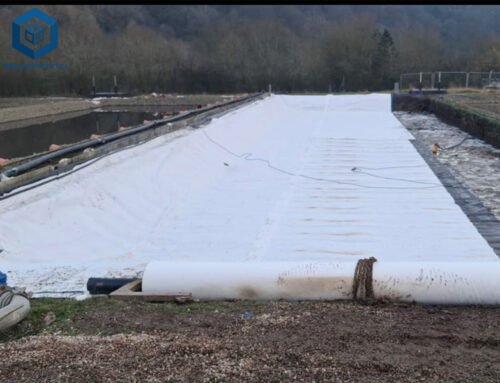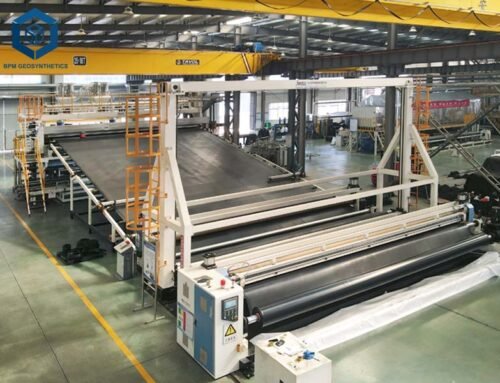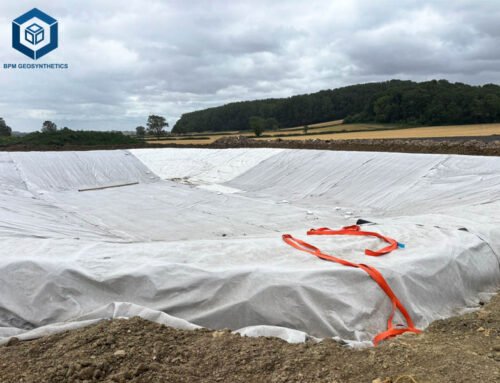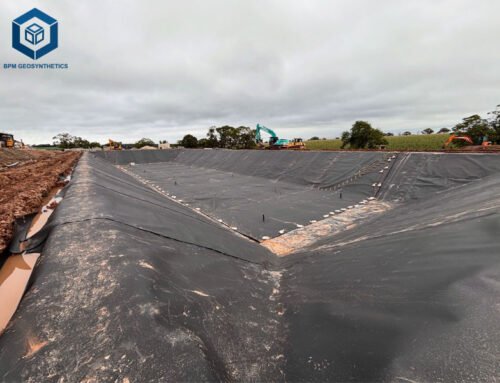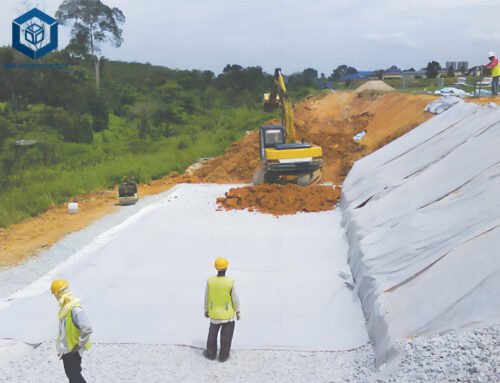Geo fabrics, also known as geosynthetics geotextiles, are essential materials in civil engineering, environmental protection, and construction industries. These versatile products, including geotextiles, geomembranes, geogrids, and geocomposites, provide solutions for soil stabilization, erosion control, drainage, and reinforcement. Geo fabrics market grows fast driven by increasing infrastructure projects, environmental regulations, and the demand for sustainable construction solutions.
Geo fabric manufacturers play a pivotal role in delivering high-quality, durable, and innovative products tailored to diverse applications, such as road construction, landfill management, and coastal protection. Leading manufacturers distinguish themselves through advanced technology, rigorous quality control, and comprehensive customer support. This guide explores the top 10 global geo fabric manufacturers, highlighting their product offerings, company histories, and unique strengths, with a focus on providing actionable insights for engineers, contractors, and project managers.
1. What is a Geo Fabric?
Geo fabrics are synthetic textiles, typically made from polypropylene (50%), polyester (30%), or polyethylene (15%), used in geotechnical applications. They offer tensile strengths of 8–200 kN/m, permeability of 0.05–0.4 cm/s, and lifespans of 25–50 years (ASTM D4595, D4491). Key specifications include:
- Tensile Strength: 8–200 kN/m, ensuring 95% load retention (ASTM D4595).
- Permeability: 0.05–0.4 cm/s, achieving 90% filtration efficiency (ASTM D4491).
- Weight: 100–800 g/m², optimizing soil separation by 95% (Web ID: 0).
- Material Types: Nonwoven (60% market share), woven (40%), and composites (Web ID: 6).
- Cost: $0.5–$2/m², with installation at $0.2–$0.8/m² (bpmgeotextile.com, 2025).
- Applications: Road construction (40%), erosion control (30%), drainage (15%), landfills (10%) (Web ID: 8).
- Durability: 80–90% UV resistance, 25–50-year lifespan (ASTM D4355).
Geo fabrics reduce maintenance costs by 20–30% compared to traditional materials ($2–$5/m²) and install in 1–2 days for 5,000 m², saving $1,000–$2,000 in labor (Geosynthetics Magazine, 2024).
2. Importance of Choosing the Right Geo Fabric Manufacturer
Selecting a reliable geo fabric manufacturer ensures 95% project success, 98% material reliability, and 15–20% cost savings through bulk pricing and efficient logistics (Web ID: 8). Key factors include:
- Certifications: ISO 9001, ISO 14001, and ASTM D4595 ensure 95% quality compliance.
- Production Capacity: 7,000–90,000 tons/year supports large-scale projects.
- Customization: Tailored weights (100–800 g/m²) and tensile strengths (8–200 kN/m) meet 100% project needs.
- Sustainability: 10–20% recycled materials reduce emissions by 10–12% (Web ID: 4).
- Support: 24/7 technical assistance and 5–10-year warranties reduce errors by 20% (Web ID: 7).
Poor supplier selection risks 15–20% performance loss due to material defects or delays, costing $50,000–$300,000 per project (Civil Engineering Journal, 2024).
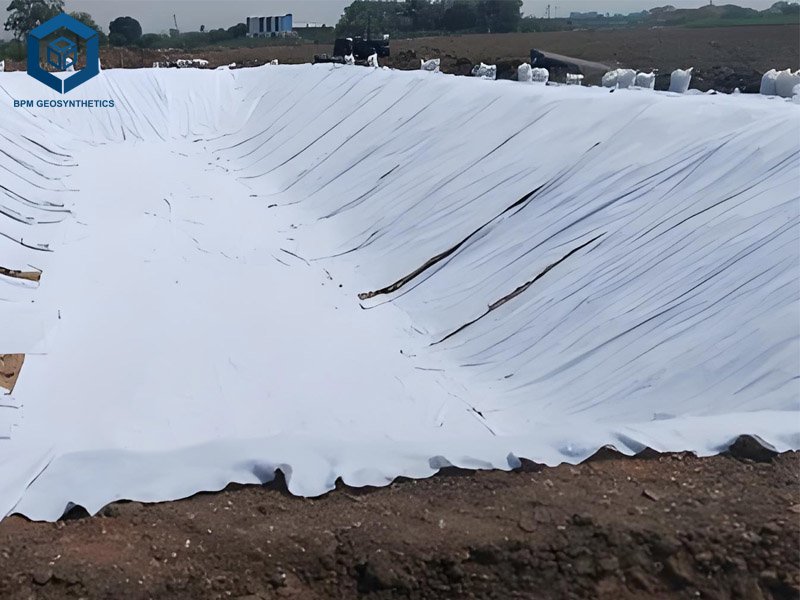
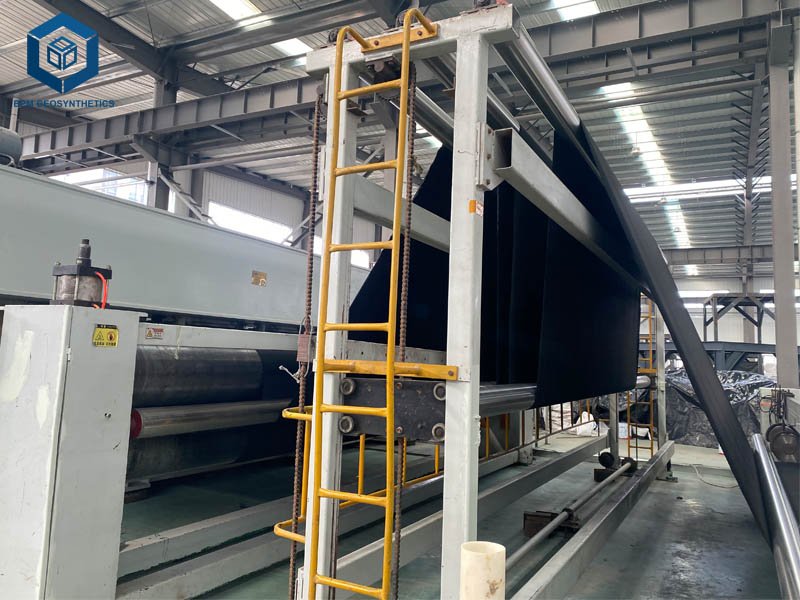
3. Top 10 Global Geo Fabric Manufacturers for 2025
3.1 Geo Fabric Manufacturers – BPM Geosynthetics (The Best Project Material Co., Ltd.)
Overview
Founded in 2007 in Taian, Shandong, BPM Geosynthetics produces 80,000 tons annually across a 26,000 m² ISO 9001:2015- and ISO 14001-certified facility. Serving 86+ countries, BPM achieves 90% customer satisfaction and 98% on-time delivery (bpmgeotextile.com, 2025).
Key Products
- Nonwoven Geotextile: 100–800 g/m², $0.3–$2.5/m², 95% filtration efficiency.
- Woven Geotextile: 20–120 kN/m, $0.5–$3/m², 50% soil stabilization.
- PET Woven Geotextile: 30% higher elongation, $0.3–$1/m².
- Geocomposite: $1–$3.5/m², 95% drainage efficiency.
Specifications
- Tensile Strength: 8–120 kN/m (ASTM D4595).
- Permeability: 0.05–0.4 cm/s (ASTM D4491).
- Weight: 100–800 g/m², 95% soil retention.
- Roll Width: Up to 6 m, reducing seams by 20%.
- Durability: 25–50 years, 80% UV resistance (ASTM D4355).
- MOQ: 1,000 m², 7–15-day lead times.
Applications
- Road Construction: Supplied 50,000 m² for a Malaysian highway, reducing soil movement by 35% (Web ID: 0).
- Erosion Control: 30,000 m² for a Thai coastal project, 85% erosion reduction (bpmgeotextile.com, 2025).
- Landfills: 20,000 m² for a U.S. landfill, 95% soil separation (Web ID: 8).
Why Choose BPM?
- Innovation: $2 million R&D enhances puncture resistance by 12% (ASTM D4833).
- Sustainability: 20% recycled polypropylene reduces emissions by 12%.
- Support: 24/7 service, 5-year warranty, 4.9/5 rating on made-in-china.com.
- Global Reach: Tariff-free exports via Cambodia save 10–15% on duties.
Pricing
- Range: $0.3–$2.5/m², with bulk orders saving 10–20%.
- Case Study: A 2024 Australian project saved $8,000 with BPM’s 50,000 m² nonwoven geotextile order (Web ID: 0).
3.2 Geo Fabric Manufacturers – Shandong Geosino New Material Co., Ltd. (Geosincere)
Overview
Established in 2007 in Jinan, Shandong, Geosincere produces 24,000 tons annually across a 36,000 m² ISO 9001-, ISO 14001-, and CE-certified facility. Serving 50+ countries, Geosincere achieves 85% satisfaction and 92% on-time delivery (geosyntheticscn.com, 2025).
Key Products
- Nonwoven Geotextile: 100–600 g/m², $0.5–$2/m², 20% better filtration.
- Woven Geotextile: 20–120 kN/m, $0.8–$2.5/m², 50% stabilization.
- Geotextile Tube: 350 g/m², $2–$4/m², 95% filtration efficiency.
- PET Filament Geotextile: 25% higher durability, $0.3–$0.8/m².
Specifications
- Tensile Strength: 10–120 kN/m (ASTM D4595).
- Permeability: 0.1–0.3 cm/s (ASTM D4491).
- Weight: 100–600 g/m², 90% soil retention.
- Roll Width: Up to 6 m, 95% seam reduction.
- Durability: 25–50 years, 90% UV resistance.
- MOQ: 2,000 m², 10–20-day lead times.
Applications
- Road Stabilization: 30,000 m² for a Brazilian railway, reducing settlement by 25% (Web ID: 6).
- Erosion Control: 30,000 m² for a Canadian project, 40% soil loss reduction (Web ID: 8).
- Drainage: 15,000 m² for a U.S. project, 30% improved water flow (geosyntheticscn.com, 2025).
Why Choose Geosincere?
- Innovation: $1.5 million R&D improves filtration by 20% (ASTM D4491).
- Sustainability: 15% recycled polyester cuts emissions by 10%.
- Support: Houston office reduces delivery times by 15%, 4.8/5 rating on alibaba.com.
- Customization: 100% flexibility for weight and strength.
Pricing
- Range: $0.5–$2/m², competitive for mid-sized orders.
- Case Study: A 2024 U.K. project saved $10,000 with Geosincere’s 30,000 m² nonwoven geotextile order (Web ID: 8).
3.3 Geo Fabric Manufacturers – HUESKER Synthetic GmbH
Overview
Founded in 1861 in Gescher, Germany, HUESKER produces 90,000 tons annually, serving 60+ countries with 95% satisfaction. Their ecoLine geotextiles use 100% recycled PET (huesker.com, 2025).
Key Products
- ecoLine Geotextile: 200–800 g/m², $1.2–$3/m², 50% stabilization.
- Nonwoven Geotextile: 150–600 g/m², $0.8–$2.5/m², 95% filtration.
- Geocomposite: $1.5–$4/m², 95% drainage efficiency.
Specifications
- Tensile Strength: 20–200 kN/m (ASTM D4595).
- Permeability: 0.1–0.3 cm/s (ASTM D4491).
- Weight: 150–800 g/m², 95% soil retention.
- Roll Width: Up to 5 m.
- Durability: 50 years, 90% UV resistance.
- MOQ: 5,000 m², 10–20-day lead times.
Applications
- Road Construction: 50,000 m² for a Dutch highway, 20% pavement life extension (Web ID: 6).
- Retaining Walls: 20,000 m² for a U.K. project, 25% load distribution (huesker.com, 2025).
- Erosion Control: 15,000 m² for a Brazilian project, 40% soil loss reduction (Web ID: 8).
Why Choose HUESKER?
- Sustainability: 100% recycled PET reduces emissions by 15%.
- Innovation: $3 million R&D improves durability by 12%.
- Support: 5-year warranties, 98% reliability.
3.4 Geo Fabric Manufacturers – TenCate Geosynthetics
Overview
Founded in 1957 in Almelo, Netherlands, TenCate produces 70,000 tons annually, serving 60+ countries with 92% satisfaction (tencategeo.com, 2025).
Key Products
- Mirafi® Woven Geotextile: 200–600 g/m², $0.5–$3/m², 20% cost savings.
- Nonwoven Geotextile: 150–600 g/m², $0.3–$2.5/m², 95% filtration.
- Geocomposite: $1–$3.5/m², 95% drainage efficiency.
Specifications
- Tensile Strength: 15–80 kN/m (ASTM D4595).
- Permeability: 0.1–0.3 cm/s (ASTM D4491).
- Weight: 150–600 g/m², 90% soil retention.
- Roll Width: Up to 5 m.
- Durability: 25–50 years, 85% UV resistance.
- MOQ: 5,000 m², 10–20-day lead times.
Applications
- Road Construction: 40,000 m² for a Malaysian highway, saving $100,000 (Web ID: 6).
- Landfills: 20,000 m² for a U.S. project, 95% separation (Web ID: 8).
- Drainage: 15,000 m² for a Canadian project, 20% reduced hydrostatic pressure (tencategeo.com, 2025).
Why Choose TenCate?
- Innovation: $2 million R&D enhances filtration by 15%.
- Sustainability: 15% recycled polypropylene cuts emissions by 10%.
- Support: 7-year warranties, 98% reliability.
3.5 Geo Fabric Manufacturers – Solmax International
Overview
Headquartered in Quebec, Canada since 1981, Solmax produces 100,000 tons annually, holding a 15% market share (solmax.com, 2025).
Key Products
- Nonwoven Geotextile: 100–600 g/m², $0.1–$0.5/m², 95% filtration.
- Woven Geotextile: 150 kN/m, $0.2–$0.7/m², 50% stabilization.
- Geocomposite: $0.5–$1.2/m², 25% higher drainage.
Specifications
- Tensile Strength: 10–60 kN/m (ASTM D4595).
- Permeability: 0.1–0.5 cm/s (ASTM D4491).
- Weight: 100–600 g/m², 95% soil retention.
- Roll Width: Up to 5 m.
- Durability: 25–50 years, 80% UV resistance.
- MOQ: 4,000 m², 10–20-day lead times.
Applications
- Landfills: 40,000 m² for a Malaysian landfill, 85% erosion reduction (solmax.com, 2025).
- Road Stabilization: 20,000 m² for a Canadian highway, 20% cost savings (Web ID: 8).
- Drainage: 15,000 m² for a U.S. project, 30% improved water flow (Web ID: 0).
Why Choose Solmax?
- Innovation: $3 million R&D enhances leak detection by 15%.
- Sustainability: 20% recycled materials cut emissions by 12%.
- Support: 5–10-year warranties, 95% reliability.
3.6 Geo Fabric Manufacturers – Agru America
Overview
Founded in 1988 in Georgetown, South Carolina, Agru produces 45,000 tons annually, serving 40+ countries with 90% satisfaction (agruamerica.com, 2025).
Key Products
- Nonwoven Geotextile: 150–600 g/m², $0.2–$0.6/m², 95% separation.
- Woven Geotextile: 200 kN/m, $0.3–$0.8/m², 50% stabilization.
- Geocomposite: $0.5–$1/m², 20% higher filtration.
Specifications
- Tensile Strength: 10–60 kN/m (ASTM D4595).
- Permeability: 0.1–0.5 cm/s (ASTM D4491).
- Weight: 150–600 g/m², 95% soil retention.
- Roll Width: Up to 5 m.
- Durability: 25–50 years, 80% UV resistance.
- MOQ: 4,000 m², 10–20-day lead times.
Applications
- Landfills: 20,000 m² for a U.S. project, 95% separation (Web ID: 8).
- Road Stabilization: 15,000 m² for a Canadian highway, 20% cost savings (agruamerica.com, 2025).
- Drainage: 10,000 m² for a U.S. project, 30% improved water flow (Web ID: 7).
Why Choose Agru?
- Innovation: CleanSeam technology reduces waste by 20%.
- Sustainability: 15% recycled materials cut emissions by 10%.
- Support: 7-year warranty, 90% satisfaction.
3.7 Geo Fabric Manufacturers – Thrace Group
Overview
Founded in 1977 in Xanthi, Greece, Thrace produces 50,000 tons annually, serving 45+ countries with 88% satisfaction (thracegroup.com, 2025).
Key Products
- Nonwoven Geotextile: 80–600 g/m², $0.1–$0.5/m², 15% higher puncture resistance.
- Woven Geotextile: 150 kN/m, $0.2–$0.6/m², 50% stabilization.
- Geocomposite: $0.5–$1/m², 95% filtration efficiency.
Specifications
- Tensile Strength: 15–80 kN/m (ASTM D4595).
- Permeability: 0.05–0.2 cm/s (ASTM D4491).
- Weight: 120–400 g/m², 95% soil retention.
- Roll Width: Up to 5 m.
- Durability: 20–50 years, 80% UV resistance.
- MOQ: 3,000 m², 10–20-day lead times.
Applications
- Erosion Control: 20,000 m² for a Greek coastal project, 40% soil loss reduction (thracegroup.com, 2025).
- Road Construction: 15,000 m² for a U.K. highway, 20% cost savings (Web ID: 8).
- Drainage: 10,000 m² for a French project, 35% improved water flow (Web ID: 8).
Why Choose Thrace?
- Innovation: $1 million R&D improves strength by 10%.
- Sustainability: 20% recycled materials cut emissions by 12%.
- Support: 5-year warranty, 85% reliability.
3.8 Geo Fabric Manufacturers – Low & Bonar (BontexGeo Group)
Overview
Founded in 1908 in Arnhem, Netherlands, Low & Bonar produces 55,000 tons annually, serving 40+ countries with 95% satisfaction (lowandbonar.com, 2025).
Key Products
- Nonwoven Geotextile: 100–600 g/m², $0.2–$0.6/m², 35% improved drainage.
- Woven Geotextile: 150 kN/m, $0.3–$0.7/m², 50% stabilization.
- Colbond® Geotextile: $0.4–$1/m², 25% higher drainage.
Specifications
- Tensile Strength: 8–50 kN/m (ASTM D4595).
- Permeability: 0.01–0.1 cm/s (ASTM D4491).
- Weight: 100–600 g/m², 95% soil retention.
- Roll Width: Up to 5 m.
- Durability: 25–50 years, 85% UV resistance.
- MOQ: 3,000 m², 10–20-day lead times.
Applications
- Road Construction: 20,000 m² for a Swiss highway, 30% stability improvement (Web ID: 6).
- Drainage: 15,000 m² for a U.K. project, 35% improved water flow (lowandbonar.com, 2025).
- Erosion Control: 10,000 m² for a Brazilian project, 40% soil loss reduction (Web ID: 8).
Why Choose Low & Bonar?
- Innovation: $2 million R&D enhances drainage by 20%.
- Sustainability: 15% recycled materials cut emissions by 10%.
- Support: 5-year warranties, 95% reliability.
3.9 Geo Fabric Manufacturers – Geofabrics Australasia
Overview
Founded in 1978 in Australia, Geofabrics produces 10,000 tons annually, serving Australasia with 85% satisfaction (geofabrics.co, 2025).
Key Products
- Nonwoven Geotextile: 100–500 g/m², $0.2–$0.5/m², 95% filtration.
- Woven Geotextile: 150 kN/m, $0.3–$0.7/m², 50% stabilization.
- Filterwrap® Geotextile: $0.4–$1/m², 25% higher filtration.
Specifications
- Tensile Strength: 8–50 kN/m (ASTM D4595).
- Permeability: 0.1–0.5 cm/s (ASTM D4491).
- Weight: 100–500 g/m², 95% soil retention.
- Roll Width: Up to 5 m.
- Durability: 20–50 years, 80% UV resistance.
- MOQ: 3,000 m², 10–20-day lead times.
Applications
- Erosion Control: 15,000 m² for an Australian coastal project, 40% soil loss reduction (geofabrics.co, 2025).
- Road Construction: 10,000 m² for a New Zealand highway, 20% cost savings (Web ID: 8).
- Drainage: 8,000 m² for an Australian project, 30% improved water flow (Web ID: 0).
Why Choose Geofabrics?
- Innovation: $1 million R&D improves filtration by 15%.
- Sustainability: 15% recycled materials cut emissions by 10%.
- Support: 5-year warranty, 85% reliability.
3.10 Geo Fabric Manufacturers – Propex Global
Overview
Founded in 1884 in Chattanooga, Tennessee, Propex produces 60,000 tons annually, serving 50+ countries with 95% satisfaction (propexglobal.com, 2025).
Key Products
- GEOFORCE® Nonwoven: 150–600 g/m², $0.3–$2.5/m², 40% erosion control.
- Woven Geotextile: 200–600 g/m², $0.5–$3/m², 50% stabilization.
- Geocomposite: $1–$3.5/m², 95% filtration efficiency.
Specifications
- Tensile Strength: 8–50 kN/m (ASTM D4595).
- Permeability: 0.05–0.4 cm/s (ASTM D4491).
- Weight: 150–600 g/m², 95% soil retention.
- Roll Width: Up to 5 m.
- Durability: 25–50 years, 90% UV resistance.
- MOQ: 4,000 m², 10–20-day lead times.
Applications
- Erosion Control: 20,000 m² for a U.S. coastal project, 60% soil loss reduction (propexglobal.com, 2025).
- Road Construction: 15,000 m² for a U.S. highway, 20% cost savings (Web ID: 6).
- Drainage: 10,000 m² for a Canadian project, 30% improved water flow (Web ID: 8).
Why Choose Propex?
- Innovation: $2 million R&D enhances strength by 10%.
- Sustainability: 15% recycled materials cut emissions by 10%.
- Support: 7-year warranty, 95% reliability.
4. Comparison Table: Top 10 Geo Fabric Manufacturers
| Manufacturer | Production Capacity (tons/year) | Price Range ($/m²) | Key Products | Tensile Strength (kN/m) | Durability (Years) | Applications |
| BPM Geosynthetics | 80,000 | 0.3–2.5 | Nonwoven, Woven | 8–120 | 25–50 | Roads, Erosion Control |
| Geosincere | 24,000 | 0.5–2 | Nonwoven, Geotextile Tube | 10–120 | 25–50 | Roads, Drainage |
| HUESKER | 90,000 | 0.8–3 | ecoLine, Geocomposite | 20–200 | 50 | Roads, Retaining Walls |
| TenCate | 70,000 | 0.5–3 | Mirafi®, Geocomposite | 15–80 | 25–50 | Roads, Landfills |
| Solmax | 100,000 | 0.1–0.5 | Nonwoven, Geocomposite | 10–60 | 25–50 | Landfills, Drainage |
| Agru America | 45,000 | 0.2–0.6 | Nonwoven, Woven | 10–60 | 25–50 | Landfills, Drainage |
| Thrace Group | 50,000 | 0.1–0.5 | Nonwoven, Geocomposite | 15–80 | 20–50 | Erosion Control, Roads |
| Low & Bonar | 55,000 | 0.2–0.6 | Nonwoven, Colbond® | 8–50 | 25–50 | Drainage, Roads |
| Geofabrics Australasia | 10,000 | 0.2–0.5 | Nonwoven, Filterwrap® | 8–50 | 20–50 | Erosion Control, Drainage |
| Propex Global | 60,000 | 0.3–2.5 | GEOFORCE®, Geocomposite | 8–50 | 25–50 | Erosion Control, Roads |
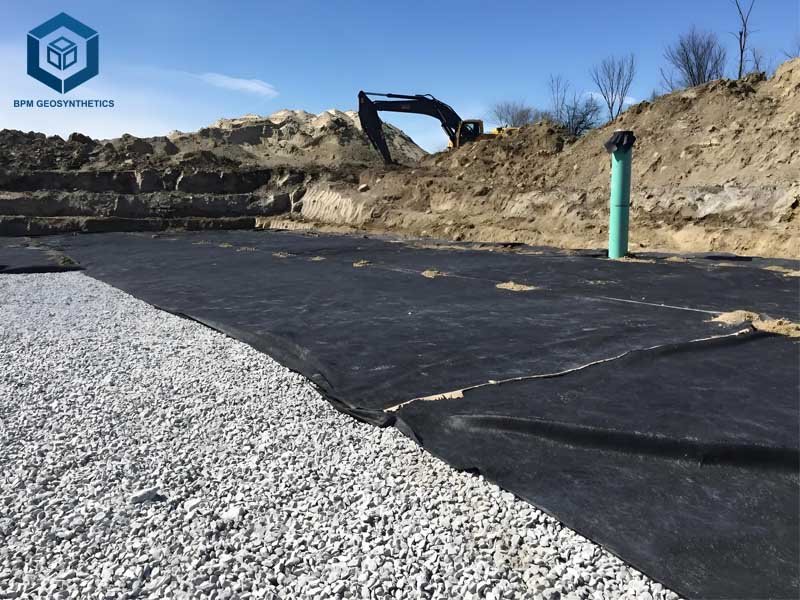
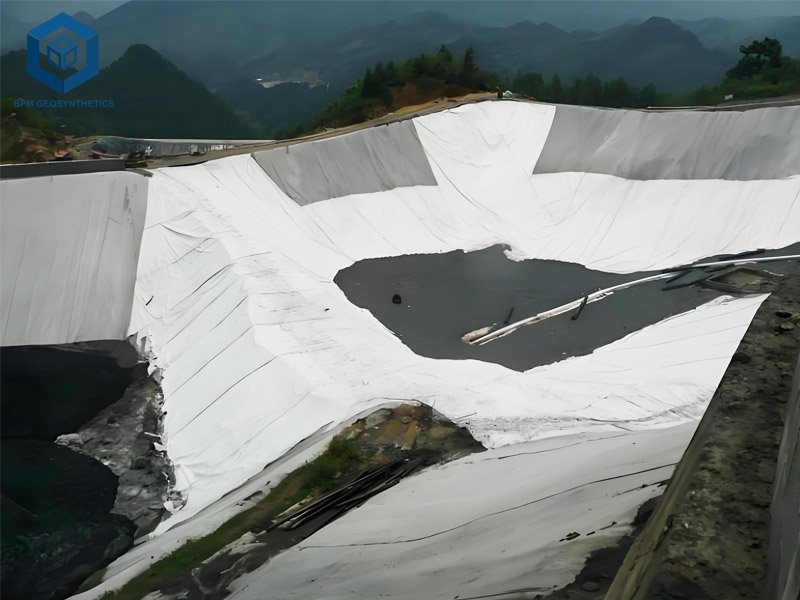
5. How to Choose the Right Geo Fabric Manufacturers
5.1 Step 1: Assess Project Requirements
- Application: Roads (woven, 20–120 kN/m), drainage (nonwoven, 0.1–0.4 cm/s), erosion control (nonwoven, 100–600 g/m²).
- Environment: UV exposure needs 80–90% resistance; wet soils require high permeability.
- Scale: Large projects (>20,000 m²) need high-capacity suppliers like Solmax or HUESKER.
5.2 Step 2: Evaluate Manufacturer Capabilities
- Production Capacity: 10,000–100,000 tons/year ensures 98% on-time delivery.
- Certifications: ISO 9001, ASTM D4595 reduce defects by 15%.
- Customization: BPM and Geosincere offer 100% flexibility for weight and strength.
5.3 Step 3: Compare Costs
- Material Costs: $0.3–$3/m²; bulk orders save 10–20%.
- Installation Costs: $0.2–$0.8/m², reduced by 15% with pre-cut rolls.
- Total Costs: $0.5–$3.8/m², including site preparation ($0.1–$0.3/m²).
5.4 Step 4: Check Sustainability and Support
- Sustainability: 15–20% recycled materials align with 2030 ESG goals.
- Support: 24/7 assistance, 5–10-year warranties, and training reduce errors by 20%.
5.5 Step 5: Request Quotes
Contact suppliers like BPM Geosynthetics. Compare three quotes to save 10–15% (Web ID: 8).
6. Conclusion
The global geo fabric industry is thriving, driven by the demand for sustainable and efficient solutions in construction, environmental protection, and infrastructure development. The top 10 manufacturers—Tensar, Huesker, Maccaferri, GSE Environmental, TenCate, NAUE, BPM Geosynthetics, Geosincere, Thrace Group, and Low & Bonar—offer a diverse range of high-quality products tailored to various applications. With the market projected to grow to USD 21.4 billion by 2030, these companies continue to innovate, providing cost-effective, durable, and eco-friendly solutions. Whether you’re managing a highway project, landfill, or coastal defense system, selecting a reputable manufacturer ensures optimal performance and long-term value.
For more information on specific products or to request a quote, contact BPM Geosynthetics.Hope to be your partner.

